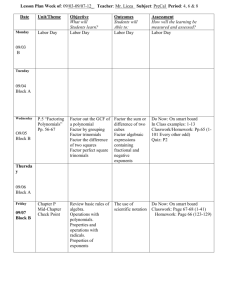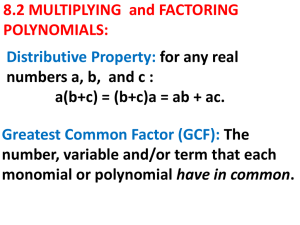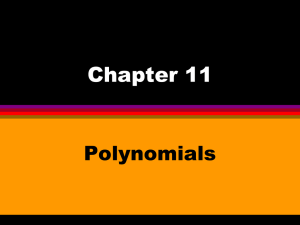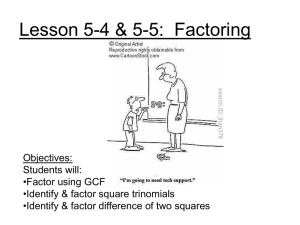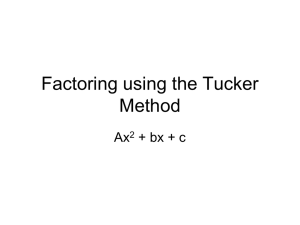Unit 7 (Chapter 7) Polynomials (P
advertisement
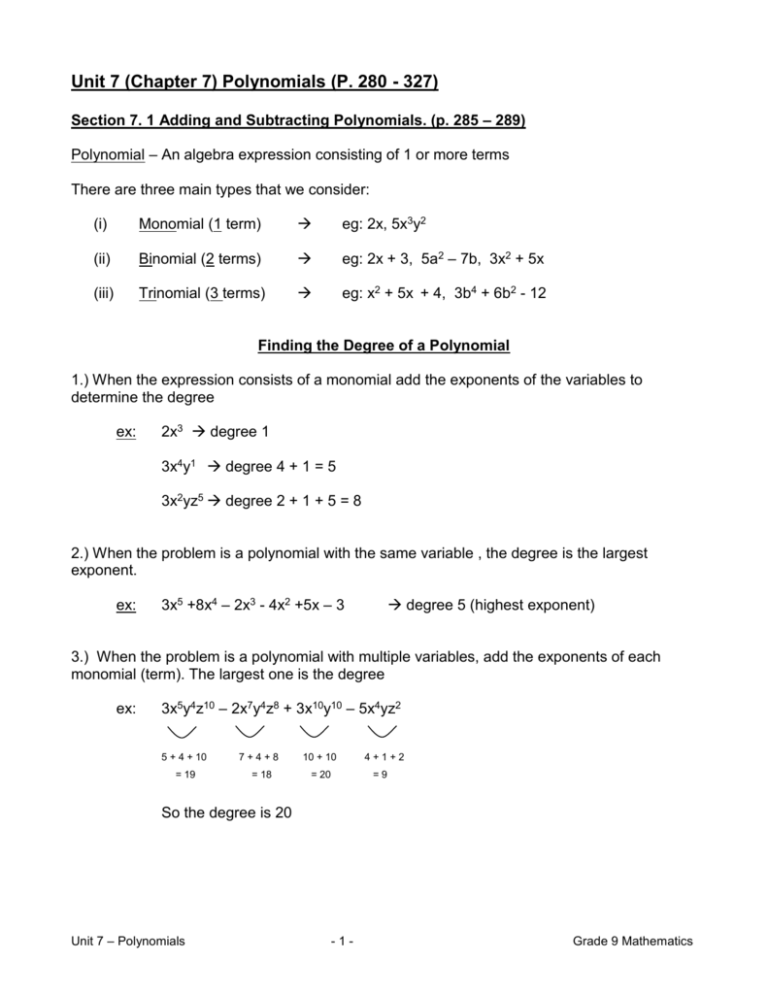
Unit 7 (Chapter 7) Polynomials (P. 280 - 327) Section 7. 1 Adding and Subtracting Polynomials. (p. 285 – 289) Polynomial – An algebra expression consisting of 1 or more terms There are three main types that we consider: (i) Monomial (1 term) eg: 2x, 5x3y2 (ii) Binomial (2 terms) eg: 2x + 3, 5a2 – 7b, 3x2 + 5x (iii) Trinomial (3 terms) eg: x2 + 5x + 4, 3b4 + 6b2 - 12 Finding the Degree of a Polynomial 1.) When the expression consists of a monomial add the exponents of the variables to determine the degree ex: 2x3 degree 1 3x4y1 degree 4 + 1 = 5 3x2yz5 degree 2 + 1 + 5 = 8 2.) When the problem is a polynomial with the same variable , the degree is the largest exponent. ex: 3x5 +8x4 – 2x3 - 4x2 +5x – 3 degree 5 (highest exponent) 3.) When the problem is a polynomial with multiple variables, add the exponents of each monomial (term). The largest one is the degree ex: 3x5y4z10 – 2x7y4z8 + 3x10y10 – 5x4yz2 5 + 4 + 10 = 19 7+4+8 = 18 10 + 10 = 20 4+1+2 =9 So the degree is 20 Unit 7 – Polynomials -1- Grade 9 Mathematics Adding and Subtracting Polynomials Recall that we can only add or subtract terms that are alike: ex: 2x, 5x, -10x are like terms Exponents must be the same when performing + or - !!! 2x2, 5x, -10x3 are unlike terms EX.1 (a) Simplify the following: 11a + 6b – 5a – 3b + 2a – 1b + 6b – 3a = 11a – 5a + 2a – 3a + 6b – 3b – 1b + 6b = 5a + 8b :regroup like parts then add/subtract as normal (b) Evaluate the above polynomial for a = 3 and b = -2 5a + 8b : simply substitute in the number for the appropriate variable = 5(3) + 8(-2) : simplify = 15 – 16 = -1 EX. 2: Simplify and then evaluate for p = -2 3p2 + 2p3 + 6p2 - 4p + 6p + 5p3 = 5p3 + 2p3 + 6p2 + 3p2 – 4p + 6p = 7p3 + 9p2 + 2p = 7(-2)2 + 9(-2) + 2(-2) = 7(4) – 18 – 4 = 28 – 18 – 4 =6 EX.3 Simplify (a) (2x2 + 3x + 4) + (1x2 – 2x – 5) = 2x2 + 1x2 + 3x – 2x + 4 – 5 = 3x2 + 1x – 1 : regrouping is not necessary but it certainly organizes the problem much better! : always be focused on BEDMAS! : regroup : combine like parts we could also use algebra tiles to solve. (This technique shown represents adding in columns with one expression on top of another.) Unit 7 – Polynomials -2- 2x2 + 3x + 4 + 1x2 – 2x – 5 Grade 9 Mathematics 3x2 + 1x - 1 3x2 + 1x – 1 (b) (-2y2 + 3y – 5) + ( -y2 – y + 1) = -2y2 - y2 + 3y – y – 5 + 1 = -3y2 + 2y – 4 = -3y2 + 2y – 4 We need to be extra careful when subtracting tems: ex: (-3) – (2) = -5 (-3) – (-2) = -3 + 2 = -1 EX.4 Simplify (a) (2x – 1) – ( -4x + 2) = 2x – 1 + 4x – 2 = 2x + 4x – 1 – 2 = 6x – 3 : when subtracting a negative it is the same as adding a positive. : use distributive property to remove brackets first. Remember the number is understood to be a 1 in front of a variable or bracket if it is not written in! In this case we are multiplying by a -1. : regroup like terms. Note the sign changes NOTE: The regrouping step is : combine like terms not necessary. It is to keep you more organized and aware of signs. Hence less careless mistakes! (b) (-2y2 – 4y + 1) – ( -4y2 – 3y + 2) = -2y2 – 4y + 1 + 4y2 + 3y - 2 = -2y2 + 4y2 – 4y + 3y + 1 – 2 = 2y2 – y - 1 = 2y2 – 1y - 1 EX.5 Simplify and evaluate for x = 1 (5x2 + 8x – 3) – (2x2 + 2x – 2) = 5x2 + 8x – 3 – 2x2 - 2x + 2 = 5x2 – 2x2 + 8x – 2x – 3 + 2 = 3x2 + 6x – 1 for x = 1 =3x2 + 6x - 1 3(1)2 + 6(1) - 1 = 3(1) + 6 – 1 =3+6 -1 =8 Unit 7 – Polynomials -3- Grade 9 Mathematics Seatwork/homework: p. 288 – 289 #5acegi, 11aceg, 12, 14ab, 16, 17ab(sketch/use algebra tiles) Section 7.2 Multiplying and Dividing Monomials (p. 290 – 294) Multiplying EX.1 State the product (a) 2x(3x) = 6x2 (b) -3a(4a3b) = -12a4b (c) 2x2(-3x2y) = - 6x4y (d) (-5y)(3y)(-2z) = 30y2z (e) (2abc)(-2abc)(3abc) = -12a3b3c3 EX.2 Simplify completely: (a) (x2y3)2 = (x2)2 (y3)2 = x4y6 We need to remember all the laws of exponents we learned in Unit 2 - chapter 5!!! : recall power to a power property (b) (x2)3 (y3)3 (z2)4 = x6 y9 z8 (c) (2 x2 y2 z4)3 = 23x6 y6 z12 = 8 x6 y6 z12 (d) (-2 a2 b3) 2 = (-2)2 a4 b6 = 4 a4 b6 (e) (-2a2 b3) 3 = (-2)3 a6 b9 (f) -(2x2 y3) 4 = -(2)4 x8 y12 = - 16 x8 y12 Seatwork/homework: p 292 #2, 5aceg, 6acegi, 7abcd, 9ace, 13aegh Dividing EX. 1 (a) 15a = -5a 3 (e) 18ab (b) = -3b 6a (c) (d) 5n 5 3n 2 = 5x 5 y 7 3x (f) -15 5n 3 3 15 x 6 y 8 9x 4 y3 5 2 y4 = 3 x9 y y 3y3 = (g) 26 p3 14 p = 15 y 4 3y3 = -5y 26 p 3 13 p 2 = 14 p 7 = 3xy Unit 7 – Polynomials -4- Grade 9 Mathematics Seatwork/homework: P. 293 #3, 8abcd, 11ace, 14aceij EX.2 Evaluate for x = -1 (a) – x 3 = - (-1) 3 = - ( -1) =1 (b) (2x 2)(x 3) = 2x 5 = 2(-1) 5 = 2(-1) = -2 : use exponent laws to simplify expression : substitute x = -1 into expression : evaluate Seatwork/homework: p. 293 #18 Section 7.3 Multiplying a Polynomial by a Monomial. (p. 295 – 299) EX.1 Expand (a) 2x(3x + 6) = 2x(3x) + 2x(6) :use distributive property : It is not necessary to show this step. Just remember the operation used and the appropriate law of exponents you perform. WATCH signs! = 6x2 + 12x (b) 3y(-2y2 – 3y + 2) = -6y3 – 9y2 +6y EX.2 Simplify (a) x(x – 1) – x(x + 1) = x2 – 1x – x2 – 1x = - 2x : using distributive property twice …WATCH signs! :combine like terms (b) -3x(x + 2) + 2x(2x – 1) = -3x2 – 6x + 4x2 – 2x Unit 7 – Polynomials -5- Grade 9 Mathematics = 1x2 – 8x EX.3 Use algebra tiles to simplify (a) 2(x + 4) remember that 2 means 2 unit tiles and x + 4 is the x-tile plus 4 unit tiles When we set up the tiles to perform multiplying these factors we sketch a rectangle that is 2 units wide and x + 4 units long: x+4 2 We now fill in the rectangle with tiles: x+4 2 We see what is inside the box are 2 x-tiles and 8 unit tiles to represent the expression 2x + 8 2(x + 4) = 2x + 8 (b) Try 2x(x + 4) We see 2 x2 tiles and 8 x–tiles so the answer is: 2x2 + 8x Unit 7 – Polynomials -6- Grade 9 Mathematics Seatwork/homework: p. 298 - 299 #1, 3aceg, 4, 5aceg, 6aceg, 8aceg Section 7.5 Dividing a Polynomial by a Monomial. (P. 306 – 308) Again we need to consider our laws of exponents for this section as well. EX.1 Simplify each of the following: 4 x 2 8x 2x (a) = : divide the denominator into each term of the numerator 4 x 2 8x 2x 2x : use simple division on the numbers (i.e. reduce fractions) and remember to subtract the exponents (quotient Rule). = 2x + 4 (b) 5 x 2 10 x 5 5 x 2 10 x = 5 5 2 =x –2 : separate expressions : reduce fractions and apply quotient rule for exponents 3b 3 6b 2 9b (c) 6b 3 3b 6b 2 9b = 6b 6b 6b 1 3 = b2 b 2 2 (d) : separate expressions : reduce fractions and apply quotient rule for exponents 10 x 2 y 5 xy 2 15 xy 5 xy : the expression can have more than one variable just remember to group and work the like parts together. 2 2 10 x y 5 xy 15 xy 5 xy 5 xy 5 xy = 2x + 1y – 3 = (e) 16a 5b 4 20a 4b 4 24a 6b 3 4 a 3b 2 = 16a 5b 4 - 20a 4 b 4 + 4a 3b 2 4a 3b 2 = 4a2b2 – 5ab2 + 6a3b Unit 7 – Polynomials 246a 6b 3 4a 3 b 2 -7- Grade 9 Mathematics Seatwork/homework: p. 307 #1ac, 2ac, 5ac, 6ac, 9 Unit 7 – Polynomials -8- Grade 9 Mathematics Section 7.4 Factoring Polynomials (p. 300 - 305) Certain definitions and skills from past courses need to be understood before we learn to factors polynomials: Factor – A whole number that exactly divides into another whole number ex: 3 is a factor of 12 because 12 3 = 4 GCF - The largest possible whole number that can divide into 2 or more quantities: ex: consider 12 and 48 - the largest number (factor) that can divide into these is 12 Prime Number – A whole number that is only divisible by one and itself (only has two factors) ex: 2, 3, 5, 7, 11, 13, 17,19, … are a few examples of prime numbers Composite number – A whole number that has more than two factors. Every composite number can be written as the product of prime factors. This product is called its prime factorization. For instance, the prime factorization of 12 is 2 · 2 · 3. The prime factorization of a whole number is the number written as the product of its prime factors. There is exactly one prime factorization for any composite number. EX.1 Express as a product of prime numbers. (Hint: it helps to make a factor tree!) (a) 36 (b) 72 6 ∙ 6 9 2 ∙ 3 ∙ 2∙ 3 8 3 3 2 4 36 = 2 2 3 3 3 3 2 2 2 72 = 3 × 3 × 2 × 2 × 2 We can use prime factorization (or factors trees) to determine the GCF of 2 or more numbers. EX.2 Determine the GCF of 24 and 36. 36 4 24 9 2 2 3 3 4 6 2 2 2 3 The GCF = multiply all those prime factors that are common in both numbers. GCF = 2 × 2 × 3 = 12 or you may find it easier to consider the prime factorization form of these two numbers: 36 = 2 × 2 × 3 × 3 24 = 2 × 2 × 2 × 3 Unit 7 – Polynomials So we see that the common factors are 2, 2, and 3. If we multiply theses together we get the greatest common factor, GCF = 2 × 2 × 3 = 12 -9- Grade 9 Mathematics EX. 3 (A) Determine the GCF of 3x2 and 12 x 3x2 12x The common factors are 3 and x 3 x2 12 x so the GCF = 3 ∙ x = 3x 3 x x 4 3 x 2 2 3 x (B) Find the GCF of 21x3y2 and 14x2y 3 The prime factorization of each of these are: 21 x3y2 = 3 ∙ 7 ∙ x ∙ x ∙ x ∙ y ∙ y 14x2y 3 = 2 ∙ 7 ∙ x ∙ x ∙ y ∙ y ∙ y : identify common factors the GCF = 7 ∙ x ∙ x ∙ y ∙ y = 7x 2 y 2 : note in the answer we have the smallest exponent of the variables given initially (C) Find the GCF of 20a3b4c5 and 15a6b2c3 20a3b4c5 = 2 ∙ 2 ∙ 5 ∙ a ∙a ∙ a ∙ b ∙ b ∙ b ∙ b ∙ c ∙ c ∙ c ∙ c ∙ c 15a6b2c3 = 3 ∙ 5 ∙ a ∙ a ∙a ∙ a ∙ a ∙ b ∙ b ∙ c ∙ c ∙ c GCF = 5 ∙ a ∙ a ∙ a ∙ b ∙ b ∙ c ∙ c ∙ c = 5a2b2c3 Try these! (D) Find the GCF of 9x16y14z12 and 3x10y19z14 Answer: 3x10y14z12 (E) Find the GCF of 10x4y5, 5x5y4, and 15x3y6 Answer: 5x3y4 Seatwork/Homework: p. 304 #1, 3 Unit 7 – Polynomials - 10 - Grade 9 Mathematics Factoring Expression with Common Factors EX. 1 Completely factor each of the following: (a) 5x + 25 = 5∙x + 5∙ 5 : using prime factorization we can determine the GCF of the terms and let that be one factor : note the common factor of 5 is pulled outside as a factor = 5(x + 5) : whatever if “left over” becomes the other factor To check if this is correct we can multiply the factors together and we should get the original expression. 5(x + 5) : use distributive property = 5(x) + 5(5) = 5x + 25 : so we know we are right! (b) (C) 9x2y2 – 6xy2 = 3∙3∙x∙x∙y∙y – 2∙3∙x∙y∙y : GCF = 3∙x∙y∙y = 3xy2 = 3xy2 (3x – 2) : this is answer in factored form 8a2b6 + 4a2bc It is not necessary to show prime factorization to determine the GCF! = 4a2b (2b5 + c) Simply consider each individual “piece” of the terms: In this case, we know that 4 is the largest factor that can be divided into 8 and 4. Also, we have also shown above that we remove the lowest exponent of the common variables given to find the GCF. So, we see that for all common variables terms the lowest exponent on a is 2 the lowest exponent on b is 1. We do not include c since it is not a common variable. Therefore, the GCF for this expression is 4 a2b. This is written in front of the other factor (the remaining terms combine to give us the other factor). Don’t forget to multiply back (use distribute property) to check to see if answer is correct! (d) 8a7b6 + a2bc = a2b(8a5b5 + c) Unit 7 – Polynomials (e) 20x3y4z5+ 15x6y5z4 – 25x5y3z = 5x3y3z(4yz4 + 3x3y2z3 – 5x2) - 11 - Grade 9 Mathematics (g) -6x2y + 3xy2 – 3x2y3 = -3xy(2x – 1y + xy2) (f) -3x2y + 9x3y2 = -3x2y(1 – 3xy) Seatwork/homework: p. 304 – 305 # 4acegi, 8acegi, 12acegi, 13acegi Factoring using Algebra Tiles Factor 4x + 8 We see this as The objective is to make these form a rectangle because length × width = area and the l × w will then be the factors of this expression. x+2 4 Thus, 4x + 8 = 4(x + 2) We could also create a rectangle like: Which would give us 2(2x + 4) as a factored expression. But since we see that the factor (2x + 4) can be factored further to 2(x + 4) we are not finished and there will be another step. We see this more clearly algebraically: 4x +8 = 2(2x +4) = 2 ∙ 2(x + 2) = 4(x + 2) Seatwork/Homework: p. 304 #5 Unit 7 – Polynomials - 12 - Grade 9 Mathematics Section 7. 6 Multiplying Two Binomials. (p. 309 – 313) FOIL Method: is a method of multiplying two binomial expressions. It is essentially using the distributive property of multiplication twice. The letters of the acronym tells what order and which terms will be multiplied. F– O– I– L– the first terms in each expression (positions a and c) the outside terms of the expression (positions a and d) the inside (middle) terms of the expression (positions b and c) the last two terms of each expression (positions b and d) Outside First (a + b) (c + d) Inside Last EX. 1 Expand (multiply) each of the following: (A) (x + 3) (x + 2) : apply FOIL method = x(x) + x(2) + 3(x) + 3(2) = x2 + 2x + 3x + 6 = x2 + 5x + 6 : group like terms (b) (2x + 4)(3x – 1) = 6x2 – 2x + 12x – 4 = 6x2 + 10x – 4 (c) (3x – 2)(5x – 4) = 15x2 – 12x – 10x + 8 = 15x2 – 22x + 8 Unit 7 – Polynomials : watch signs when multiplying! - 13 - Grade 9 Mathematics Multiplying Binomials using Algebra Tiles EX.2 Use algebra tiles to expand (multiply) the following: (a) (x + 2) (x + 3) (x + 3) (x + 2) = x2+ 5x + 6 (b) (2x + 2)(2x – 1) (2x - 1) = 4x2+ 2x - 2 (2x + 2) (c) (3x + 1) (2x + 1) (2x + 1) = 6x2+ 5x +1 (3x + 1) Seatwork/homework: p. 311 – 313 # 8, 9, 10, 11, 13,15, 17 Unit 7 – Polynomials - 14 - Grade 9 Mathematics Section 7.7 Factoring Trinomials. (p. 314 – 320) Recall, a polynomial with three terms is called a trinomial. ex: x2 + 5x + 6, 2x2 – 7x + 12 When we multiply two binomials together we often get a trinomial ex: (x + 2)( x + 3) = x2 + 5x + 6 (2x + 3) ( x – 4) = 2x2 – 5x – 12 Factoring is the process of reversing this multiplication (FOIL) process. ex: factoring x2 + 5x + 6 will give us (x + 2)(x + 3) There are several ways to factor trinomials. We will look at factoring in two ways: (1) using a method called product and sum (sometimes called trial and error or guess and check) and (2) using algebra tiles. EX.1 Factor each of the following (a) x2 + 5x + 6 =( )( ) We need to determine two binomials so that if we foiled we get the original equation. If we consider the foiling process we know that if we multiply the first terms together we get the first term in the trinomial. Hence, we know that the first two terms are x and x x ∙ x = x2 So we have: = (x ) (x ) We also know that from the foiling process the last terms multiplied give us the last term in the trinomial. Think: What two numbers multiply to be 6? 1 and 6, -1 and -6, 2 and 3, or -2 and -3 So, how do we know what we need to choose? We have also seen from the multiplying the outside and inside terms that they end up being grouped together to give the middle term of the trinomial. Think: Which of these two factors will give us 5 if we add them? 2 and 3 Therefore we can write the above trinomial as a product of two factors: = (x + 2) (x + 3) (b) x2 + 8x + 15 = (x + 5)(x +3) Unit 7 – Polynomials : think: What two number multiply to be 15 and add to be 8? 5 and 3 : check by foiling. If you get the original equations then you are correct. - 15 - Grade 9 Mathematics (c) x2 – 1x – 6 = (x – 3)(x + 2) :what two numbers × to be -6 and + to be -1? -3 and 2 (d) x2 + 3x – 28 = (x – 7)(x + 4) : what two values × to be -28 and + to be 3? -7 and 4 (e) x2 – 7x + 10 = (x – 2)(x – 5) : what two numbers × to be 10 and + to be -7? -2 and -5 In previous examples we see the leading coefficient as 1. There are times when this will be another number other than 1. It then becomes necessary to factor out the GCF before we use product and sum method. EX.2 Factor completely. (a) 5x2 + 10x + 40 = 5(x2 + 2x + 8) : determine GCF of 5,10, 40 GCF = 5 (same as leading coefficient) : now determine the two values whose product = 8 and sum = 2 Note: we can not determine these two factors so we are done. (b) 4x2 – 16x – 20 = 4(x2 – 4x – 5) = 4(x – 5)(x + 1) : factor the leading coefficient GCF = 4 : determine two numbers that × to be -5 and + to be -4 (c) 4x2 + 8x – 12 = 4(x2 + 2x – 3) = 4(x + 3)(x – 1) :factor the GCF first : think of two #’s that × = -3 and + = 2? -1 and 3 : Note: it does not matter which order the factors are written in. -5, 1 TRY THESE! (d) 6x2 - 42x + 60 (e) 2x3 + 14x2 + 20 Seatwork/ homework: p. 319 # 11acegi, 12acegi, 13acegi, 14acegi, 19 Unit 7 – Polynomials - 16 - Grade 9 Mathematics Factoring using Algebra Tiles Once again we can use algebra tiles to rearrange into rectangles. Remember as we showed earlier the l × w gives us the factors. EX.1 Factor using algebra tiles: (a) x2 + 6x + 8 We are using 1 x2 tile , 6 x-tiles and 8 unit tiles to form a rectangle Rearrange in a rectangular form and determine the length and the width which will represent the factors of the trinomial. x+2 x+4 Hence x2 + 6x + 8 = (x + 2)(x + 4) (b) x2 + 4x + 4 (c) x2 + 7x + 6 x+1 x+2 x+6 x+2 x2 + 4x + 4 = (x + 2)(x + 2) Unit 7 – Polynomials x2 + 7x + 6 = (x + 1)(x + 6) - 17 - Grade 9 Mathematics Seatwork/homework: p. 318 #4, 5 Binomial Products – Special Cases ex: (x + 3)(x – 3) = x2 – 3x + 3x – 9 = x2 - 9 Difference of squares Notes: The factors are the same except for the sign. The middle terms will cancel Left with two perfect squares that are subtracted (this is why it is called difference of squares). EX.1 Expand each of the following: (a) (x + 9)(x – 9) = x2 – 9x + 9x – 81 = x2 – 81 (b) (a + 5)(a – 5) : since middle terms will cancel it is only necessary to complete F and L of the FOIL method. = a2 – 25 (c) (10x + 3)(10x – 3) = 100x2 – 9 (d) (3x – 2y)(3x + 2y) = 9x2 – 4y2 Seatwork/Homework: p. 313 #15, 16 Perfect Squares EX.2 Expand each of the following: (a) (x + 3)2 = (x + 3)(x + 3) = x2 + 3x + 3x + 9 = x2 + 6x + 9 : squaring a binomial means multiplying by itself (remember the square exponent does not mean square each separate term inside the bracket!) (b) (x - 5)2 = (x – 5)(x – 5) = x2 – 5x – 5x + 25 Unit 7 – Polynomials (c) (2x + 1)2 = (2x + 1)(2x + 1) = 4x2 + 2x + 2x + 1 - 18 - Grade 9 Mathematics = x2 – 10x + 25 = 4x2 + 4x = 1 Factoring Binomials (Difference of Squares) Once again factoring is the reverse of foiling. EX.1 Factor (a) x2 – 25 = (x + 5) (x – 5) : note the difference of two perfect squares (b) x2 – 9 = (x – 3)(x + 3) : It does not matter what order the factors are written. (c) 49 – x2 = (7 – x)(7 + x) (d) 9x2 – 16 = (3x – 4)(3x + 4) (e) y2 + 49 : Can NOT be done! There is no such thing as factoring sum of squares. Seatwork/ Homework: Assign worksheet Unit 7 – Polynomials - 19 - Grade 9 Mathematics Perimeter and Area EX.1 (a) Find an expression for the perimeter of the rectangle. P = 2l + 2w = 2(5x – 1) + 2(3x) = 10x – 2 + 6x = 16x – 2 3x 5x - 1 (b) What is the perimeter if x = 2m? P = 16x – 2 = 16(2) – 2 = 32 – 2 = 30 the perimeter is 30 m. (c) Find an expression for the area of the above rectangle A=l×w = (5x – 1)(3x) = 15x2 – 3x (d) What is the area if x = 2m? A = 15x2 – 3x = 15(2)2 – 3(2) = 15(4) – 3(2) = 60 – 6 = 54 m2 : simply substitute the 2 in for x and simplify : don’t forget the units!!! EX.2 What is the total length of all edges in the figure shown? 3x 4(x) + 4(x + 2) + 4(3x) = 4x + 4x + 8 + 12x = 20x + 8 : use distributive property : group like terms x x+2 Unit 7 – Polynomials - 20 - Grade 9 Mathematics 2x EX.3 Consider the figure 2x - 2 4x 3x + 1 6x + 3 (A) Determine the perimeter First it is necessary to determine the measures of the missing sides 2x 2x - 2 4x 4x 3x + 1 6x + 3 6x + 3 a 2x Perimeter b c 3x + 1 2x - 2 = all sides added together = 2(2x) + 2(3x + 1) + 2(2x – 2) + 2(4x) + 2(6x + 3) = 4x + 6x + 2 + 4x – 4 + 8x + 12x + 6 = 34x + 4 Found by (6x + 3) – (4x) (B) Find the total area of the figure. It is clearly easier to find the area of the 3 rectangles (a, b, and c) then add these to get total. A (rect a) = L × W = 2x(6x + 3) = 12x2 + 6x A (rect b) = L × W = (3x + 1)(2x + 3) = 6x2 + 8x + 2x + 3 = 6x2 + 10x + 3 Total Area = Areaa + Areab + Areac = 12x2 + 6x + 6x2 + 10x + 3 + 12x2 – 6x – 6 = 30x2 + 10x – 3 Unit 7 – Polynomials - 21 - A(rect c) = L × W = (2x – 2)(6x + 3) = 12x2 + 6x – 12x - 6 = 12x2 – 6x – 6 : group like terms Grade 9 Mathematics EX.4 TRY THIS ONE! Consider this shape 4x + 6 3x 3x + 1 2x + 2 (A) Find the perimeter (B) Find the total area EX.5 AND THIS ONE! Determine the total perimeter and area of the figure below. x-4 3x 2x + 1 Unit 7 – Polynomials - 22 - Grade 9 Mathematics EX.6 (a) Find an expression for the area of the shaded region. Both shapes are rectangles. 2x + 1 2x + 5 x 2x + 10 Area of shaded region = Area of large rectangle – Area of small rectangle =L×W L×W = (2x + 10) (2x + 5) (2x+ 1)(x) 2 = 4x + 10x + 20x + 50 (2x2 + x) 2 = 4x + 30x + 50 (2x2 + x) = 4x2 + 30x + 50 – 2x2 – x = 2x2 + 29x + 50 (b) If x = 1m, find the area of the shaded region Areashaded = 2x2 + 29x + 50 = 2(1)2 + 29(1) + 50 = 2 + 29 + 50 = 81 m2 Seatwork/Homework: Unit 7 – Polynomials : don’t forget units! p. 324 #2 - 23 - Grade 9 Mathematics


